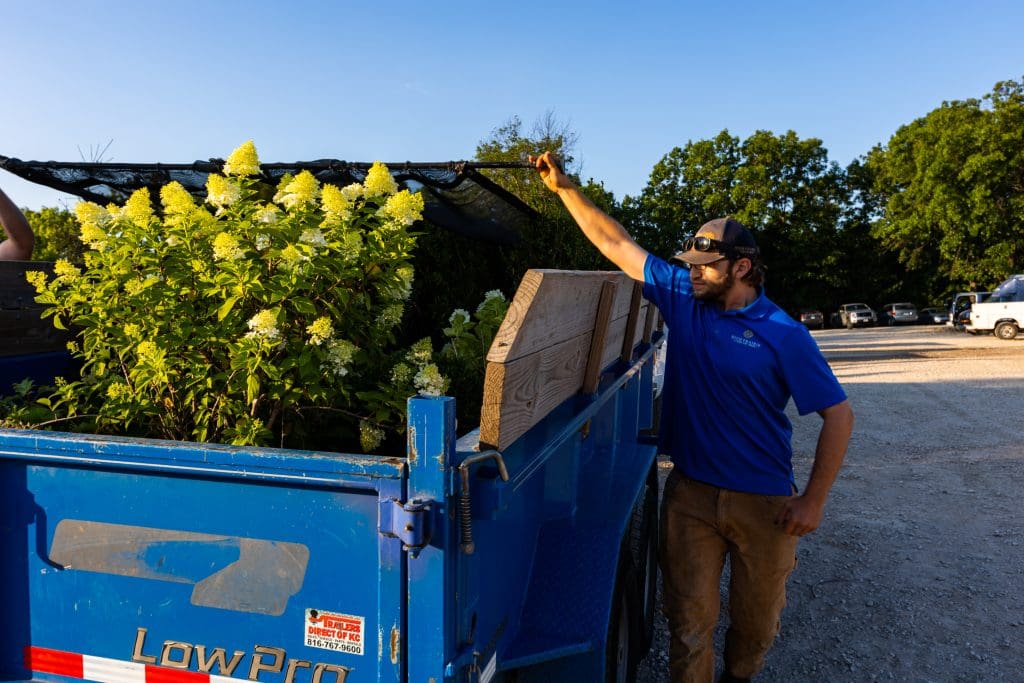
Change orders, permitting issues and unsuitable weather are all possible causes of project delays that can result in the plant material you were ready to install to be put on standby for days or even weeks.
Robyn Schmitz, owner and CEO of High Prairie Landscape Group, LLC, based in Edwardsville, Kansas, estimates they have to deal with plant install delays due to project delays approximately 10 to 15% of the time.
“Job delays are common today, even with the best project management practices, because there are still ripples of supply chain volatility,” Schmitz says.
Jeff Rossen, CEO of Rossen Landscape, based in Great Falls, Virginia, says during the pandemic, they dealt with major delays and lost a lot of plant material because of these setbacks.
Reducing Delays
While typically, project delays are from unforeseen issues, such as a buried pipe that calls for rethinking a design, there are still ways to lessen the chance of plant installation delays.
“My advice is to always visit sites or projects before starting,” says Lixsomar “Lex” Anguiano, a project manager with Chalet, based in Wilmette, Illinois. “Most questions are simple to resolve by looking and walking around the project. Discuss questions with clients and designers about the work to be done. Get a clear image of the scope of work. After you have your answers, take the time to walk the property and look at your notes to see if you forgot anything that can become an issue later. Do not be afraid of asking a tough question. You can prevent most delays with proper thinking. I like to think of the worst-case scenario whenever I visit a property. I look for potential problems and try to get ahead of them.”
Rossen says they go to great lengths to ensure they do not bring in plant material before it is needed.

“If we have a job that has permitting or something that we know may potentially hold it up, we do not order the plants until we’ve cleared permitting and we know that we’re imminently going to do the job,” Rossen says.
If the plant is sitting in the nursery for more than four weeks, Rossen says it’s a red flag. He says even when properly cared for the plant material is 50 percent more likely to fail when delayed.
“Scientifically, plants that are installed in the ground are more insulated from weather extremes and tend to have a higher survival rate than plants awaiting installation,” Schmitz says. “The sooner you can responsibly install your plants in a well-amended, properly dug spot, the better.”
Preserving Plant Material
If a delay does occur, Jeff Korhan, founder of True Nature Marketing, says the first step is to inform the client what is going on and why. Then you should reach out to your plant grower or nursery to see if they can hold on to the plant material for a bit longer as they are better equipped to care to the plants.
Schmitz agrees that you should try to reschedule the delivery and logistics with the nursery if the plants haven’t arrived yet.
“If the delivery was direct to jobsite, we try to move plant material and few times as possible to prevent damage to rootballs, trunks, etc.,” she says. “In this case, we’ll set up temporary watering, shade, and any insulation/mulch we need. This could include spigot timers with drip hose, or tripod sprinklers.”
Depending on your company facilities, you may have a dedicated area with an irrigation system to care for your delayed plant material. Anguiano says plant storage isn’t an issue for them. They take plant material on a daily basis and plant it either the same day or the following day. He says they try to minimize the transportation of the plant material.
If you don’t have shade houses or a holding area, Korhan suggests placing the plants on the north side of a building for shade.
Monitoring the plants for signs of wilt or disease is critical. Korhan advises having people checking on the plants at least twice daily for warning signs. He says having an employee hand water helps them pay closer attention to the plants. Rossen Landscape has an irrigated nursery and on the weekends they have an employee who comes in to check on the plants.

“Consider how long you’ll be storing the material when deciding what type of system to put in place to temporarily care for the plants,” Schmitz says. “If it’s only a day or two, you may just have a team member hand water. We firmly believe that temporary drip hose with a spigot timer is a much better option, so your crew hours are used on productive work, not unbillable hose-holding. As you’re setting up a temporary space, consider lighting, wind, the need for root-ball insulation, and how you can least inconvenience the client.”
Aside from monitoring and watering the plants, Anguiano says they make sure the roots are moist and covered by mulch or dirt. Balled and burlapped plant material is harder to maintain. Rossen says heeling them in with wood chips around the root balls can keep the plants from drying out.
“Pea gravel can be one of your best friends,” Korhan says. “If you have a container and put it in a larger container and fill that up with pea gravel, that would accomplish several things. Number one, the pea gravel would water the plant slowly and it would insulate it.”
Korhan also suggests lightly pruning the crown of shrubs back so the root system has less to support. He notes that wherever the plant material is stored, they shouldn’t be packed in too tightly where they can’t get good airflow.
“Plant material can be cared for,” Anguiano says. “No matter how long delays are, with proper planning and thinking far enough in advance you can properly take care of them.”

